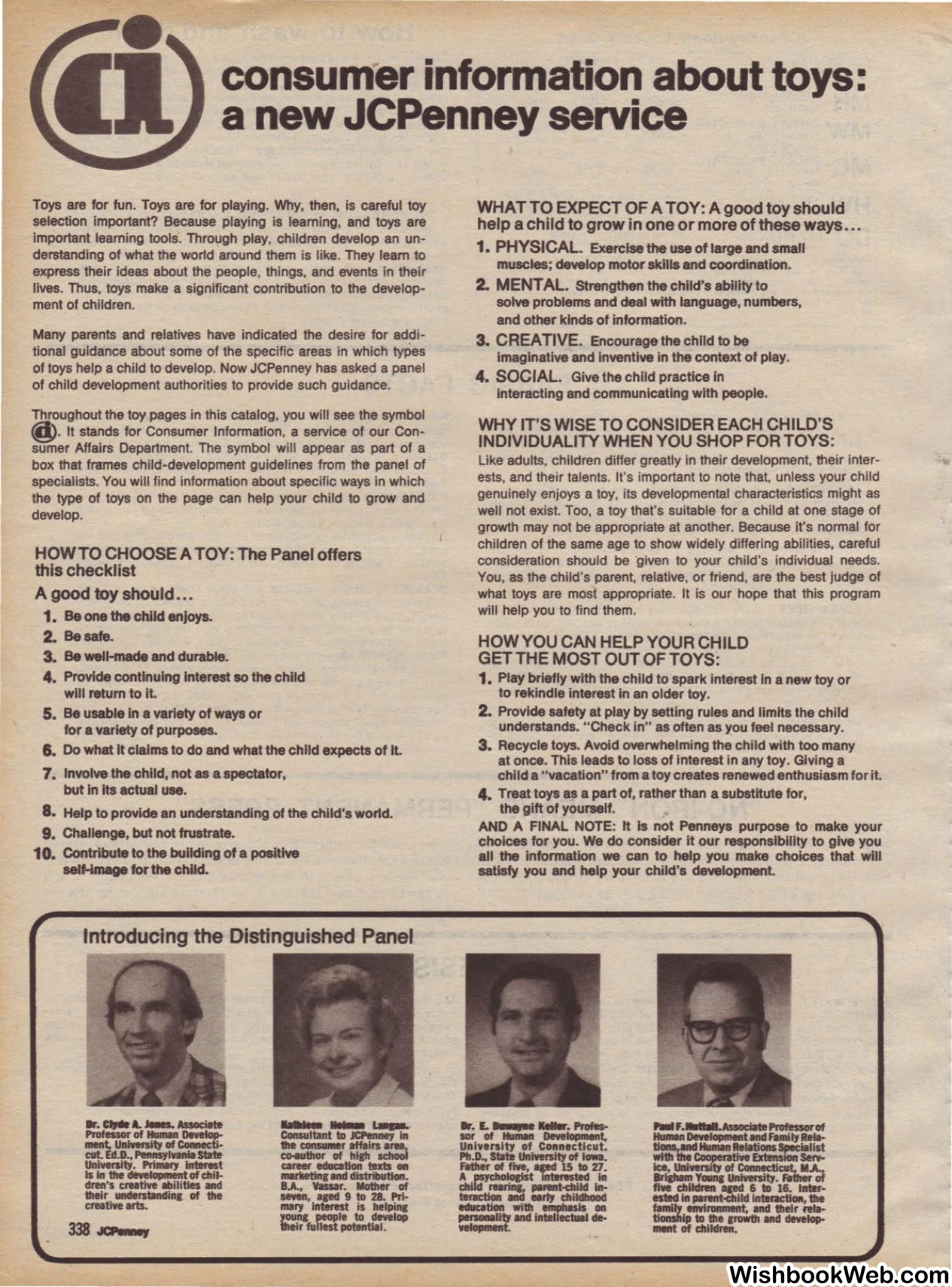

consumer information about toys:
a
new JCPenney service
Toys are for fun. Toys are for playing. Why, then, is careful toy
selection important? Because playing is learning, and toys are
important learning tools. Through play, children develop an un–
derstanding of what the world around them is like. They learn to
express
their ideas about the people, things, and events in their
lives. Thus, toys make a significant contribution to the develop–
ment of children.
Many parents and relatives have indicated the desire for addi–
tional guidance about some of the specific areas in which types
of toys help a child to develop. Now JCPenney has asked a panel
of child development authorities to provide such guidance.
Throughout the toy pages in this catalog, you will see the symbol
@.
It stands for Consumer Information, a service of our Con–
sumer Affairs Department. The symbol will appear as part of a
box that frames child-development guidelines from the panel of
specialists. You will find information about specific ways in which
the
type
of toys on the page can help your child
to
grow and
develop.
HOWTO CHOOSE A TOY: The Panel offers
this checklist
A good toy should •••
1.
Be
one
the
child enjoys.
2.
Besafe.
3.
Be
well-made and durable.
4.
Provide continuing Interest
so
the child
will return to il
5.
Be
usable In a variety of ways or
for a
variety
of purposes.
6.
Do what
It
claims to
do
and
what the child expects of
ll
7.
Involve the child, not
as
a spectator,
but
In
Its
actual use.
8.
Help to provide an understanding of the child's world.
9.
Challenge,
but
not frustrate.
1O.
Contribute
to
the
building of a
positlw
self-image
for
the
child.
Introducing the Distinguished Panel
Ir.
CIJ*
A. .......
Auoclltlt
Professor
of
Hunmn
11evei.
-t.
IJmftrsltJ
of
c-ti–
cut.
Ed.D., PennsylVMla
state
University.
Prl•ry
Interest
Is
In
the
developmentofcbiJ–
dren's cn111tive
abilities
and
their understa11dln1
of
the
creative arts.
....................
Consultant
tu
JCPenney
In
the -
llffalrs anNI,
co-euthor
of
high
school
career edacatlon
tuts
on
marlletlng
Incl
distribution.
B.A.,
V-r. Mother
·of
-. aeed
9
tu
28.
Pri–
mary
Interest
is helpinc
younc
people
tu
develop
their fullest potentilll.
WHAT TO EXPECT OF A TOY: A good toy should
help a child to grow in one or more of these ways ...
1. PHYSICAL.
Exercise
the
use
of large and small
muscles; develop motor skllls and coordination.
2.
MENTAL.
Strengthen the child's ability to
solve
problems and deal
with
language, numbers,
and other kinds of information.
3. CREATIVE.
Encourage the child to be
imaginative and inventive in the context of play.
4. SOCIAL.
Give the child practice In
interacting and communicating with people.
WHY IT'SWISE TO CONSIDER EACH CHILD'S
INDIVIDUALITYWHEN YOU SHOP FOR TOYS:
Like adults, children differ greatly in their development, their inter–
ests, and their talents. It's important to note that. unless your child
genuinely enjoys a toy, its developmental characteristics might as
well not exist. Too, a toy that's suitable for a child at one stage of
growth may not
be
appropriate at another. Because it's normal for
children of the same age to show widely differing abilities, careful
consideration should be ·given to your child's individual needs.
You, as the child's parent, relative, or friend, are the best judge of
what toys are most appropriate. It is our hope that this program
will help you to find them.
HOWYOU CAN HELP YOUR CHILD
GET THE MOST OUT OF TOYS:
1.
Play briefly with the child to spark interest In a new toy or
to rekindle interest in an older toy.
2.
Provide safety at play by setting rules and limits the child
understands. "Check in" as often
as
you feel necessary.
3.
Recycle toys. Avoid overwhelming the child with too many
at once. This leads to loss of interest in any toy. Giving a
child a "vacation" from a toy creates renewed enthusiasm for it.
4.
Treat toys as a part of, rather than a substitute for,
the gift of yourself.
AND A FINAL
NOTE:
It
Is not Penneys purpose to make your
choices for you. We do consider It our responsibility to give you
all
the
information
we can
to help you make choices that will
satisfy
you and help your child's development
Ir. L .............
Prufes–
sor
of
Huw Developiwt,
University of Connecticut.
Ph.D.,
State
University
of
1-.
Father
of
five,
and
15
tu
'D.
A
ldzdiOloclst
Tnblns1ed
In
chi
reerinc,
PINllt-chlld
ln–
terKtion
anCI .,.,
cblldhood
lducetion with
tmDhasls
on
pe.-llty
and
inteliectal
de–
velopment.
....,.......Associata
Pnlfessorof
ltunllll
Developmentlnd
fllllilJ
Rell–
---.anc1
Hulllln
Relati-Spec!lllst
wttlt
the
Cooperative
Extension
Serw–
lc:e,
University
of
Connecticut.
II.A.,
Brlllml
Y-c
IJmftrsltJ.
r.ther
of
five
clllldnn
qed
6
tu
16. lntllr–
estld Ill P1rent-c:hlkl
lntaractlcll,
the
tamllY
811Yirunment,
and
their
Rll–
tlonsfllp
tu
the
lrowth
and
develop–
Rat
of
clllldren.
















